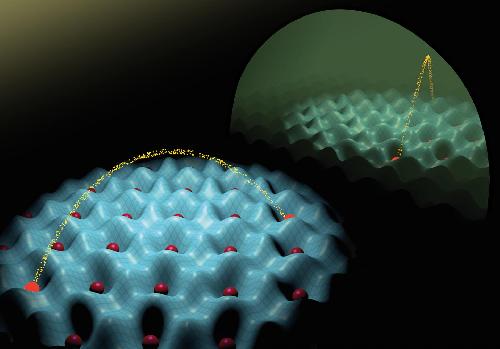This news release is available in German.
When water in a pot is slowly heated to the boil, an exciting duel of energies takes place inside the liquid. On the one hand there is the interaction energy that wants to keep the water molecules together because of their mutual attraction. On the other hand, however, the motional energy, which increases due to heating, tries to separate the molecules. Below the boiling point the interaction energy prevails, but as soon as the motional energy wins the water boils and turns into water vapour. This process is also known as a phase transition. In this scenario the interaction only involves water molecules that are in immediate proximity to one another.
A team of researchers led by Tilman Esslinger at the Institute for Quantum Electronics at ETH Zurich, and Tobias Donner, a scientist in his group, have now shown that particles can be made to "feel" each other even over large distances. By adding such long-range interactions the physicists were able to observe novel phase transitions that result from energetic three-way battles.
 An artificial quantum world of atoms and light: Atoms (red) spontaneously arrange themselves in a checkerboard pattern as a result of the complex interplay between short- and long-range interactions. Credit: ETH Zurich / Tobias Donner
An artificial quantum world of atoms and light: Atoms (red) spontaneously arrange themselves in a checkerboard pattern as a result of the complex interplay between short- and long-range interactions. Credit: ETH Zurich / Tobias Donner
Artificial quantum worlds
The physicists did not, of course, perform their experiments in a cooking pot, but rather in an artificially created quantum world called a "quantum simulator". To do so, the researchers cooled a tiny cloud of rubidium atoms to temperatures just above absolute zero and then caught them in a crystal-like lattice made of laser beams. The interaction energy stems from collisions between atoms that move back and forth between lattice sites. The motional energy of the atoms, on the other hand, can be controlled through the intensity of the laser beams, which determines how easily the atoms can move inside the lattice.
Finally, in order to bring about an interaction between atoms that are far apart, Renate Landig, a PhD student in Esslinger's group, and her colleagues used a technical trick. Using two highly reflecting mirrors they built a resonator that ensured that light particles scattered by one of the atoms would fly through the rubidium cloud several times. In that way, sooner or later all the atoms in the cloud come into contact with the scattered photon. They thus "feel" the presence of the original atom that first deviated the photon. This feeling over a distance is tantamount to an effective long-range interaction. How strongly the atoms interact in this way can be exactly controlled through the frequency of the laser beams.
"Using this trick we now have three competing energy scales in our system: besides the motional and interaction energies there is, in addition, the energy associated with the long-range interaction", explains Landig. "By varying the motional energy and the long-range interaction energy, we are able to study a number of novel quantum phase transitions."
First order phase transitions
The researchers were already familiar with some of the possible phase transitions. For instance, when the long-range interaction is very small and the motional energy is increased little by little, the phase of the rubidium cloud changes from a Mott insulator, with one immobile atom sitting on each lattice site, to a superfluid, in which atoms can move completely freely.
If, by contrast, the researchers increase the long range interaction energy, something completely different happens. At a particular strength of that interaction the atoms spontaneously arrange themselves in a checkerboard pattern, with one empty lattice site between two atoms. "The peculiarity of this phase transition, which is similar to that between water and water vapour, is that it's a first order transition", Donner emphasizes. In such phase transitions a particular property of a substance changes suddenly, whereas second order phase transitions, which are the type of transitions that have been detected in artificial quantum systems up to now, are characterized by a gradual change.
Supersolidity detected
The physicists were also able to induce another unusual phase transition by making both the motional energy and the long-range interaction energy very large. In that case, too, a checkerboard pattern appeared inside the lattice, but this time there was phase coherence between the atoms - in other words, their quantum mechanical wave functions were synchronized. Phase coherence is usually only observed when the atoms are relatively free to roam, as is the case, for instance, in the superfluid state. The coexistence of a checkerboard pattern and phase coherence at the same time indicates that one is dealing with a supersolid phase. The hybrid state of supersolidity was theoretically predicted as much as fifty years ago, but thus far unambiguously detecting it has proved difficult.
In the future, Esslinger and his collaborators will use their quantum simulator to study such exotic effects more closely. The researchers' aim is to get a general idea of quantum phenomena in increasingly complex systems. This, in turn, goes hand in hand with the development and investigation of materials with special properties.
The research was undertaken in conjunction with TherMiQ, a European research project examining the thermodynamics of mesoscopic open quantum systems.
source: ETH Zurich